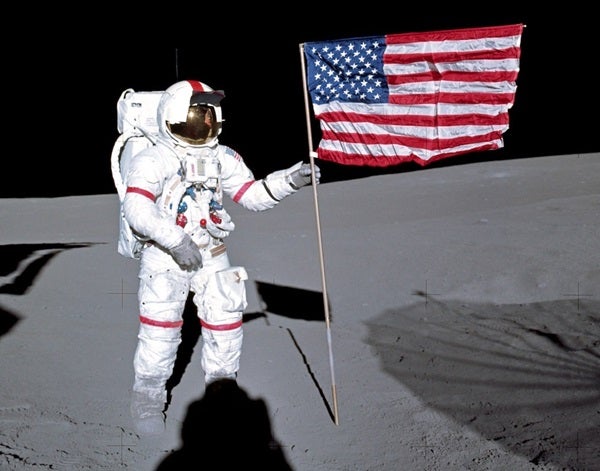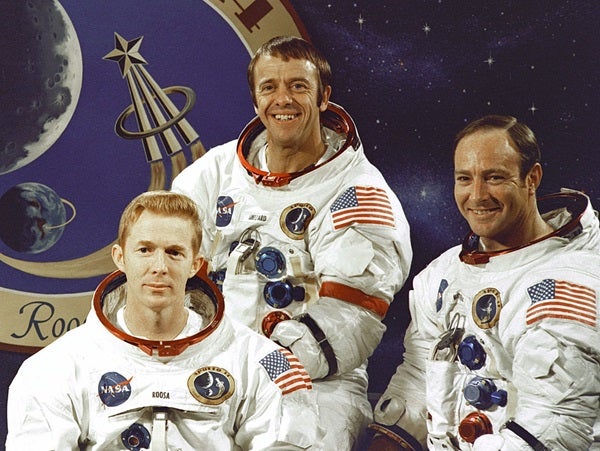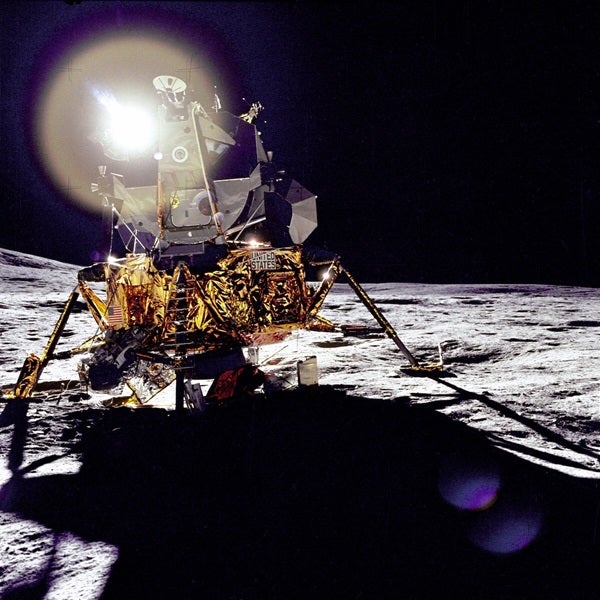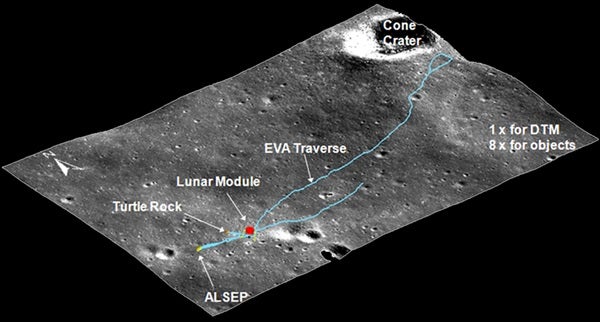The cataclysmic impact spewed molten material over hundreds of miles, forming a patch of low hills dubbed Fra Mauro. And in January 1971, three men set off on Apollo 14 to explore this wild place, hoping to reveal clues about the youth of our closest celestial neighbour.
Yet, youth was not on their side. When 47-year-old Commander Alan Shepard planted his boots into the powdery lunar soil, he became the oldest person to walk on the Moon — a record which still stands some 50 years later. His backup crew, a decade younger, even produced tongue-in-cheek Roadrunner stickers and slogans, their incessant “Beep-Beeps” a constant reminder than they could easily catch up to him.
“It’s been a long way,” Shepard breathed upon Apollo 14’s arrival to the Moon, “but we’re here.” As he gazed into the lunar sky and saw the Earth hanging in the darkness, no bigger than a marble, emotion overwhelmed him. For a second or two, the hardened test pilot wept.
Shepard was America’s first astronaut. Ten years before, he rode the Freedom 7 capsule into space before being struck by an inner ear ailment that almost ended his flying career. Surgery saved him, however, and with Command Module Pilot Stuart Roosa and Lunar Module Pilot Edgar Mitchell, Shepard was assigned to the crew of the third Moon landing.
But the stakes unforgiving. The tricky-to-reach Fra Mauro site had been the target for Apollo 13, whose enduring tale of triumph against all odds would eventually find its way to the silver screen. President Richard Nixon had already cancelled three lunar missions. And since only Shepard had previously flown (and for only 15 minutes), the Apollo 14 astronauts were one of the least experienced crews in NASA history.
A date with the Moon
On the overcast afternoon of January 31, 1971, as a persistent drizzle shrouded Florida, Shepard, Roosa, and Mitchell launched atop a Saturn V, the largest and most powerful rocket ever brought to operational status. They were on their way to their date with the Moon.
But like many dates, it almost fell flat. Attempts to link the Command and Service Module (Kitty Hawk) with the Lunar Module (Antares) failed five times due to contaminants in the docking mechanism. Without Antares, their lunar adventure was over.
Fortunately, Roosa eventually succeeded in bringing the two ships together. Four days and 240,000 miles (386,000 km) later, Apollo 14 slipped into lunar orbit, with a low point just 9 miles (14.5 km) above the surface. This maneuver saved Antares fuel and gave Shepard and Mitchell extra hover time to pick a suitable landing spot within the rugged terrain. Yet, the gremlins had other cards to play.
Soon after undocking from Kitty Hawk (where Roosa remained), Shepard and Mitchell noticed the red light of Antares’ abort switch glimmering on the instrument panel. Neither Shepard nor Mitchell had touched it. And at the time, they didn’t realize a tiny sliver of metal was trapped inside the switch, floating freely among the electrical contacts and making random connections. Apollo 14’s landing was postponed until the problem could be fixed. The switch had to be bypassed, but it also needed to be functional if a real abort became necessary.
“It was a hell of a risk-gain trade,” remembered Flight Director Eugene Kranz. But a software patch was devised to lock out the switch, and if an abort situation did occur, the astronauts would instead manually command it with Antares’ keypad. It was a dicey strategy, but it was their only chance to land on the Moon.
Then, only minutes into the powered descent of Antares’, its radar failed to lock on to the surface. Shepard and Mitchell were 4 miles (6.5 km) above Fra Mauro and the airwaves were tense. They repeatedly cycled the radar’s circuit breaker. “Hell, it works with my toaster,” Mitchell wryly observed before achieving success in the nick of time. Antares landed only 180 feet (55 m) from its intended target.
A never-ending lunar hike
The astronauts spent 33 hours on the lunar surface and completed two moonwalks lasting over 9 hours in total. The first saw them erect an American flag on the lunar surface, set up scientific instruments meant to induce artificial moonquakes, and prepare a rickshaw-like Modular Equipment Transporter (MET) to carry their geological tools. (Apollo 14’s mischievous backup crew had secretly filled the MET with Roadrunner and “Beep-Beep” paraphernalia and joked that its real purpose was for carrying “Old Man Shepard” whenever he grew tired.)
After an uncomfortable night’s sleep in hammocks aboard Antares, the men returned outside the next day to explore nearby, 1,000-foot-wide (305 km) Cone Crater, whose rocks might offer insights into the dramatic Mare Imbrium impact. But with few reference points to gain their bearings or judge distance on the intractable, Sun-bleached gray landscape, Shepard and Mitchell could never be truly sure how close they were to the crater’s rim.
Finally, just before returning inside Antares for the last time, Shepard dropped a golf ball into the fine lunar dust and gave it a hearty whack with the handle of his soil-sampling tool. (He kept the prank a closely guarded secret before the mission’s launch, even sneaking out of the crew quarters in the dead of night to practice his swing.) On the Moon, his inflexible suit meant he could only hit the ball one-handed. But for Shepard, a keen golfer, it was still a triumph. “Miles and miles,” he beamed.
After returning to Kitty Hawk and a happy Roosa the next day, Apollo 14 headed home, splashing down in the South Pacific on February 9, 1971.
Shepard’s record as the oldest moonwalker should be eclipsed in the coming years by the Artemis Generation. And perhaps a future team of lunar explorers will also make it to the edge of Cone Crater to behold the impressive vista across its yawning chasm. And just maybe, sporting new, more flexible space suits that are currently under development, future lunar golfers may even experience fewer difficulties with their backswing.













